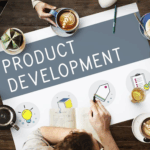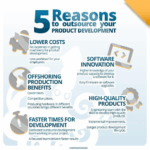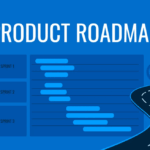“Success doesn’t happen by chance; it’s crafted with precision.” In the world of product creation, this couldn’t be more true. Yet, many businesses struggle with misalignment between product management and product development. And do you know what can happen when these two roles aren’t aligned? It often leads to delays, budget overruns, and products that miss the mark with customers.
If you are frustrated by shifting priorities, technical roadblocks, or unclear goals, you know how challenging it can be to create something truly remarkable. But fear not; today, we are going to eradicate all your confusion!
In this blog, we’ll break down the differences and overlaps between product management and product development, showing how these teams can work together to avoid common pitfalls and drive success.
Defining Product Management: Strategy and Oversight
Product management is the strategic oversight of a product from conception to launch and beyond. Product management is all about:
- Market Research: Analyzing customer needs and competitor landscapes.
- Roadmap Creation: Developing strategic plans to prioritize features and timelines.
- Stakeholder Communication: Acting as a bridge between technical teams, business executives, and customers.
Product managers are the visionaries, steering the product toward market success. Their key responsibilities include.
- Strong communication and leadership.
- Analytical and decision-making abilities.
- Understanding of market trends and user behavior.
According to a 2024 report by Product School, organizations with dedicated product management teams experience a 37% higher success rate in product launches.
Understanding Product Development: From Concept to Reality
Product development, on the other hand, is the technical and creative process of building the product. It transforms the product manager’s vision into reality. The core of product development includes:
- Designing and Prototyping: Creating initial sketches, mockups, and functional prototypes.
- Testing and Iteration: Refining the product based on feedback.
- Collaboration: Working with engineers, designers, and supply chain teams to ensure feasibility.
Product Developers blend technical expertise with creativity to turn concepts into real-world solutions that meet user needs. They have:
- Technical expertise in engineering or design.
- Creativity and problem-solving abilities.
- Attention to detail and project management skills.
In 2024, companies leveraging AI-driven tools in product development reported a 25% reduction in production time, showcasing the power of automation.
Product Management Vs. Product Development
| ASPECT | PRODUCT MANAGEMENT | PRODUCT DEVELOPMENT |
| Focus | Strategic vision and Market fit | Technical execution and functionality |
| Output | Roadmaps, market strategies | Prototypes, finalized product |
| Team composition | Managers, analysts, Marketers | Designers, engineers, researchers |
While product managers define what the product should achieve, product developers work on how to achieve it. Together, they create products that are both innovative and market-ready.
Collaboration Between Product Management and Product Development
“Teamwork makes the dream work.” The interplay between product management and product development is critical. Both teams need to align on goals, timelines, and customer expectations.
Tools for Collaboration
- Jira: Streamlines task management.
- Slack: Facilitates communication.
- Figma: Enhances design collaboration.
According to a survey, businesses that foster strong collaboration between these roles are 45% more likely to meet their product goals.
Challenges in Product Management and Development
- Challenges in Product Management
Some of the problems in product management are:
- Balancing flexibility with responding to changes in customer needs.
- Coordinating competing priorities and aligning different stakeholders.
- Effectively utilizing big data to inform decisions.
These challenges make it necessary to achieve a proportional equilibrium between visionary planning and quantitative analysis to keep the product’s relevance to consumers and organizational objectives in check.
- Challenges in Product Development
As with any product development process, key challenges are
- Keeping up with rapidly changing tools and methods.
- Managing within budgets and strict timelines.
- Ensuring the product meets technical requirements while satisfying end-user needs.
As the saying goes, “When the going gets tough, the tough get going.” These roles require resilience, adaptability, and a commitment to effective team collaboration.
Emerging Trends and Future Prospects
The world of product management and development is evolving with trends that reshape how teams operate:
- AI-Powered Workflows: The digital twin, or using predictive analytics and generative design tools, is becoming almost mandatory. With ChatGPT, for example, routine processes are eliminated; with Autodesk Dreamcatcher, iterations are made much more efficient.
- Sustainability: At 45%, the consumer shift is towards environmentally friendly products, so teams are being tasked with creating sustainable solutions.
- Personalization: Industry players deploy Analytical CRM to design unique experiences that are compelling to certain users, thereby improving customer satisfaction.
These trends are not luxuries for businesses to consider. They are needs that should be regarded as the norm. The adoption of these innovations by companies in 2024 also revealed that customer retention rates were boosted by 30% among firms that implement such changes as they seek to make advances in a highly competitive world.
Real-Life Examples
Tesla
Tesla’s product management team envisions cutting-edge features like self-driving capabilities while its development team innovates to deliver them. This collaboration has made Tesla a leader in the electric vehicle industry.
Amazon
Amazon’s seamless product management and development integration is evident in its Prime services, which continuously evolve based on customer data and technical advancements.
Choosing Your Path: Management or Development?
As the idiom goes, “Different strokes for different folks.” Both paths offer immense opportunities to shape the future of industries.
Deciding on Product Management is perfect for those who love strategy, communications, and market insights. This involves managing the frames of the product and ensuring that what the team is doing is in line with the company objectives while, at the same time, the product should be able to meet the customer’s needs. It is well suited for individuals who tend to coordinate various components for positive results.
On the other hand, choosing product development is suitable for those who want to be involved in technical thinking and actual production. This path enables one to work on new product development, construction, and optimization, concentrating on the creation and practical application of solutions. In binary words, Product development recommends itself to those who like to work with technologies and prototypes and love the precise implementation of the result.
The Overlaps: Where the Magic Happens
Despite their differences, product management and product development share common ground. Both:
- Rely on customer feedback to refine their approaches.
- Use iterative processes to ensure quality.
- Aim to deliver value to users and stakeholders.
Organizations that integrate these roles effectively see better product outcomes and faster market penetration.
Conclusion: The Interconnected Roles of Product Management and Development
According to H. Ford: “Coming together is the beginning; keeping together is progress, and working together is a success.”
Product management and product development are two practices that may or may not overlap depending on various factors. They are, in fact, two complementary processes that are vital for the proper functioning of product lifecycle management. Even though they reflect different stages of the product’s life cycle, they cannot be implemented without each other. Interacting with both roles, businesses can create objects that are not only economically rational but also satisfy the market demand.
Let’s embrace the harmony between these roles and drive innovation into the future.
More Interesting Reads
Want to learn more? Discover these informative reads from Brand New MD.
- What Is Product Sourcing? A Quick Guide
- Global Sourcing vs Local Sourcing: What to Consider
- The Secret to Market Domination: Strategic Product Features
- The Definitive Guide to Product Sourcing for Amazon FBA
- Product Development Team Structure Explained
https://review42.com/resources/customer-retention-statistics/ Harvard Business Review








